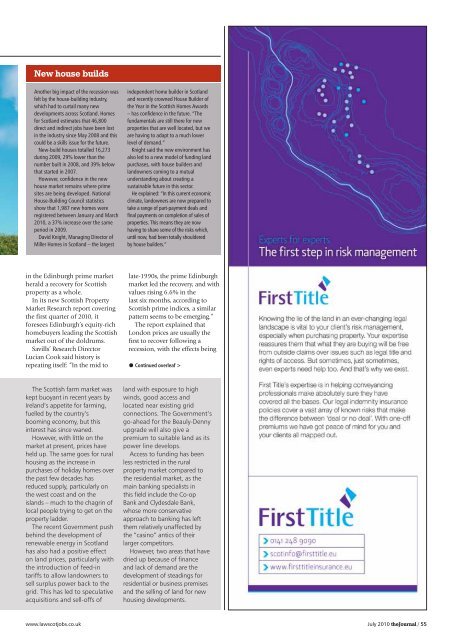Professional briefing - The Journal Online
Professional briefing - The Journal Online
Professional briefing - The Journal Online
You also want an ePaper? Increase the reach of your titles
YUMPU automatically turns print PDFs into web optimized ePapers that Google loves.
New house builds<br />
Another big impact of the recession was<br />
felt by the house-building industry,<br />
which had to curtail many new<br />
developments across Scotland. Homes<br />
for Scotland estimates that 46,800<br />
direct and indirect jobs have been lost<br />
in the industry since May 2008 and this<br />
could be a skills issue for the future.<br />
New-build houses totalled 16,273<br />
during 2009, 29% lower than the<br />
number built in 2008, and 39% below<br />
that started in 2007.<br />
However, confidence in the new<br />
house market remains where prime<br />
sites are being developed. National<br />
House-Building Council statistics<br />
show that 1,987 new homes were<br />
registered between January and March<br />
2010, a 37% increase over the same<br />
period in 2009.<br />
David Knight, Managing Director of<br />
Miller Homes in Scotland – the largest<br />
in the Edinburgh prime market<br />
herald a recovery for Scottish<br />
property as a whole.<br />
In its new Scottish Property<br />
Market Research report covering<br />
the first quarter of 2010, it<br />
foresees Edinburgh’s equity-rich<br />
homebuyers leading the Scottish<br />
market out of the doldrums.<br />
Savills’ Research Director<br />
Lucian Cook said history is<br />
repeating itself: “In the mid to<br />
<strong>The</strong> Scottish farm market was<br />
kept buoyant in recent years by<br />
Ireland’s appetite for farming,<br />
fuelled by the country’s<br />
booming economy, but this<br />
interest has since waned.<br />
However, with little on the<br />
market at present, prices have<br />
held up. <strong>The</strong> same goes for rural<br />
housing as the increase in<br />
purchases of holiday homes over<br />
the past few decades has<br />
reduced supply, particularly on<br />
the west coast and on the<br />
islands – much to the chagrin of<br />
local people trying to get on the<br />
property ladder.<br />
<strong>The</strong> recent Government push<br />
behind the development of<br />
renewable energy in Scotland<br />
has also had a positive effect<br />
on land prices, particularly with<br />
the introduction of feed-in<br />
tariffs to allow landowners to<br />
sell surplus power back to the<br />
grid. This has led to speculative<br />
acquisitions and sell-offs of<br />
www.lawscotjobs.co.uk<br />
independent home builder in Scotland<br />
and recently crowned House Builder of<br />
the Year in the Scottish Homes Awards<br />
– has confidence in the future. “<strong>The</strong><br />
fundamentals are still there for new<br />
properties that are well located, but we<br />
are having to adapt to a much lower<br />
level of demand.”<br />
Knight said the new environment has<br />
also led to a new model of funding land<br />
purchases, with house builders and<br />
landowners coming to a mutual<br />
understanding about creating a<br />
sustainable future in this sector.<br />
He explained: “In this current economic<br />
climate, landowners are now prepared to<br />
take a range of part-payment deals and<br />
final payments on completion of sales of<br />
properties. This means they are now<br />
having to share some of the risks which,<br />
until now, had been totally shouldered<br />
by house builders.”<br />
late-1990s, the prime Edinburgh<br />
market led the recovery, and with<br />
values rising 6.6% in the<br />
last six months, according to<br />
Scottish prime indices, a similar<br />
pattern seems to be emerging.”<br />
<strong>The</strong> report explained that<br />
London prices are usually the<br />
first to recover following a<br />
recession, with the effects being<br />
Continued overleaf ><br />
land with exposure to high<br />
winds, good access and<br />
located near existing grid<br />
connections. <strong>The</strong> Government’s<br />
go-ahead for the Beauly-Denny<br />
upgrade will also give a<br />
premium to suitable land as its<br />
power line develops.<br />
Access to funding has been<br />
less restricted in the rural<br />
property market compared to<br />
the residential market, as the<br />
main banking specialists in<br />
this field include the Co-op<br />
Bank and Clydesdale Bank,<br />
whose more conservative<br />
approach to banking has left<br />
them relatively unaffected by<br />
the “casino” antics of their<br />
larger competitors.<br />
However, two areas that have<br />
dried up because of finance<br />
and lack of demand are the<br />
development of steadings for<br />
residential or business premises<br />
and the selling of land for new<br />
housing developments.<br />
July 2010 the<strong>Journal</strong> / 55










